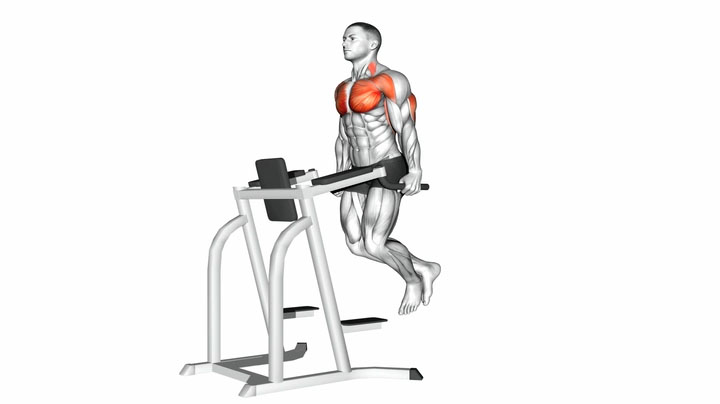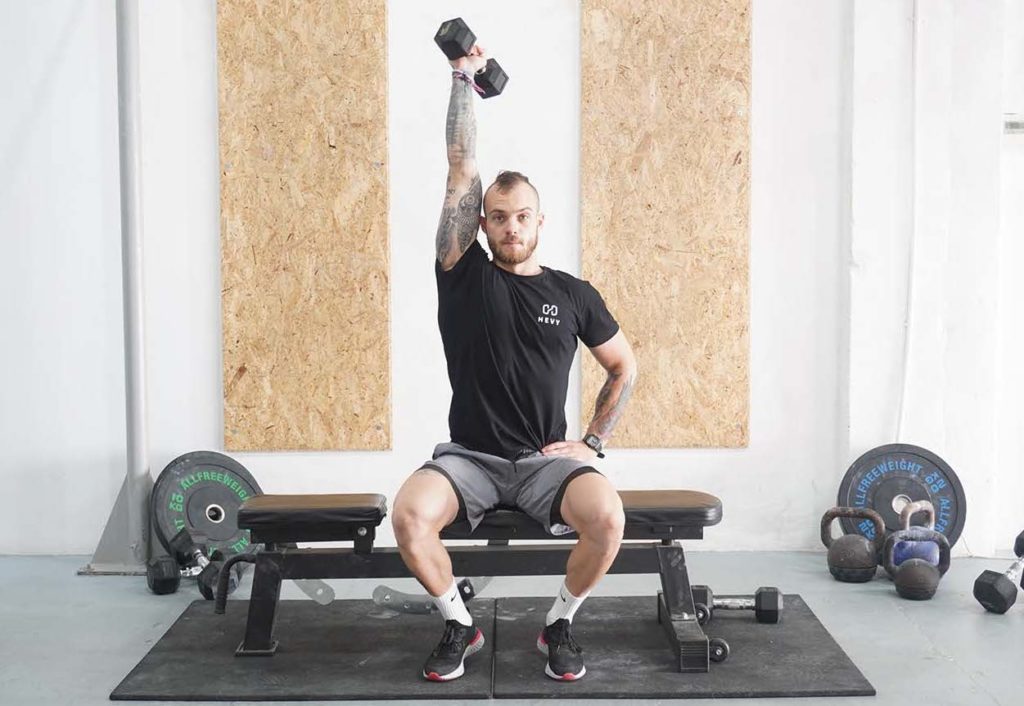Strengthening the Arms with Tricep Kickbacks
Tricep kickbacks are an effective isolation exercise that builds mass and strength in our elbow extensors. The goal is to grab a dumbbell, bend forward, raise your elbow to torso level, and begin extending your arm repeatedly. Doing so isolates your triceps and improves your core stability.
Kickbacks are also beneficial because the exercise requires a single dumbbell, and you don’t need fancy equipment to target your triceps effectively. You can even do kickbacks at home.
Having strong triceps is valuable for a variety of reasons. Most notably, the triceps contribute to your pressing strength. The stronger they are, the easier it is to perform activities like lifting objects above your head and locking out your elbows against resistance. Strong triceps also make you more athletic and improve your performance in basketball, American football, tennis, and more.
We recommend including tricep kickbacks late into your training, preferably one of the last movements.
How to do a Tricep Kickback
- Grab a light dumbbell and hold it to your side with your palm facing your thigh.
- Bring your torso forward as you push your butt back to maintain a neutral back.
- Lift your elbow to your side, inhale, and extend your arm by engaging your tricep.
- Once your arm is entirely straight, hold the contraction for a second, exhale, and slowly bring the dumbbell back down.
- Keep your shoulder and elbow in a stationary position throughout each repetition.
What muscles does the tricep kickback activate?
As their name suggests, kickbacks activate the triceps (1). The objective is to extend our arms while holding a pair of dumbbells in our hands, which forces the triceps to engage (2). Our triceps play a minor role in shoulder stability because the long head originates from the scapula and crosses the shoulder joint.
Aside from training the triceps, kickbacks activate some trunk and midsection muscles that flex isometrically to provide stability. Our abs, transverse abdominis, obliques, serratus anterior, erector spinae, trapezius, and other muscles help us maintain our position while performing the exercise.
Tips on Proper Form and Technique when Performing a Tricep Kickback
An essential tip for tricep kickbacks is maintaining a neutral spine once you bend forward. Some trainees allow their back to round, placing unnecessary stress on the spine. Keep your shoulders retracted and back straight throughout the movement.
Another tip to consider for kickbacks is keeping your elbows steady as you do repetitions. Raise your elbows to torso level and keep them anchored to your sides, ensuring that the only movement occurs when bending and straightening your arms. Doing so is beneficial for keeping more tension on your triceps, forcing them to work extra hard.
The third tip for tricep kickbacks is to perform repetitions smoothly and with a full range of motion. Start with your knuckles pointing to the floor and gradually extend your arms until your elbows are locked out.

Picking the appropriate weight for kickbacks is also essential. As discussed earlier, kickbacks are an isolation movement. So, pick dumbbells that allow you to perform at least 12 to 15 smooth repetitions with a full range of motion.
Variations and Modifications of the Tricep Kickback
1. Cable Tricep Kickback
Cable kickbacks are an excellent variation to develop your triceps. The variation is beneficial because gravity doesn’t influence cables, leading to consistent tension from start to finish. In contrast, dumbbells offer the most resistance at the top, but tension dissipates as you lower the weight.
2. Resistance Band Tricep Kickback
Like cable kickbacks, using a resistance band is beneficial because of the consistent tension you place on your muscles. The primary difference is, resistance bands offer more resistance as you lengthen them, culminating in a forceful contraction as you straighten your arms.
Mistakes to Avoid
One of the most common mistakes with tricep kickbacks is not keeping your elbows steady while doing repetitions. Many trainees move their elbows back and forth in the direction of the weight. Doing so isn’t ideal because it robs your muscles of tension, making each repetition less effective. Avoid the mistake by anchoring your elbows to your sides from start to finish.
Another mistake with kickbacks is shortening the range of motion, which typically results from too much weight. Extend your elbows on every repetition and lower the weights until your knuckles point to the floor. Doing so will lead to a more potent growth stimulus.
The third mistake with tricep kickbacks is swinging the weight back and forth. Doing so might allow you to use more weight and do extra repetitions, but it prevents you from activating the triceps. Perform each repetition slowly and with reasonable control, holding the top position for a moment. Controlled reps will keep the tension on your triceps, forcing them to grow and strengthen.
Similar Exercises to the Tricep Kickback
Triceps Rope Pushdown

Rope pushdowns are an excellent isolation exercise for the triceps. The objective is to grab a rope attachment, brace your core, anchor your elbows to your sides, and extend your arms repeatedly. Using a rope reinforces proper technique and might help you activate your triceps better than using a straight bar.
Chest Dip

Chest dips are an effective compound exercise that overloads your triceps, causing high levels of mechanical tension for muscle growth (1, 3). The objective is to support yourself on a dip bar without letting your feet touch the floor. Once in position, lower yourself (dip), and engage your triceps, chest, and shoulders to push yourself to the top.
Overhead Tricep Extension (Dumbbell)

Similar to kickbacks, overhead tricep extensions are a simple and effective isolation exercise (1). The objective is to grab a dumbbell, raise it over your head, keep your elbow steady, and lower the weight behind your head. From there, engage your tricep to raise the dumbbell back to the top position.



